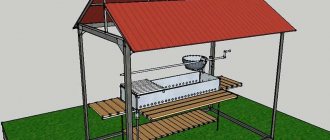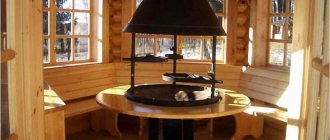A large number of people use a device such as a rope ladder in their work. And although ordinary people often see it at playgrounds and in the circus, workers of the Ministry of Emergency Situations, economic departments of housing and communal services, climbers and speleologists must keep this device in their arsenal. The main requirement is 100% safety during operation. The article will discuss various types of rope ladders, their technical parameters and methods of making them yourself.
Conventional staircase design using plastic rungs and rope strings
Characteristics of rope ladders
Moving on to the topic of how to make a rope ladder, you need to understand what technical requirements are imposed on this device. The main indicator is strength. This applies to all models without exception. Other requirements:
- Ropes for playgrounds are made from natural materials.
- Representatives of fire brigades and the Ministry of Emergency Situations use non-flammable materials.
- Climbers pay special attention to such an indicator as frost resistance.
- Climbers prefer ladders made of strong but thin rope.
Regarding technical characteristics and dimensional parameters.
- The width of the stairs is within 45 cm.
- Length – no more than 15 m.
- Weight – no more than 20 kg.
- Minimum load – 300 kg.
- Rope thickness – 7-10 mm. You can’t go any thinner, it will cut your hands; any thicker – the weight of the device will increase.
- Distance between steps: for children – 30 cm, adults – 45 cm.
Security measures
It is easy to guess that rope ladders do not have a high level of safety. Therefore, there is a whole list of precautions that must be observed:
- The steps of the stairs should not be sharp and impede movement.
- The length of the product should not be more than 15 meters in length and less than 25 centimeters in width.
- There should be no more than 35 cm between each step.
- If round rather than flat steps are used, their diameter should be less than 2.5 cm.
- If the ladder is portable, then its weight should not exceed 20 kg.
- The device must be able to support the weight of an adult. Ideally, it should withstand 300 kg.
- It is recommended to make special stops that will prevent the ladder from colliding with the wall. Otherwise, the lifting process will be complicated.
Material for production
A rope ladder consists of 2 elements: rope (string), steps. For official use, rope is made from synthetic materials: nylon, nylon, polypropylene, etc. Their strength is higher than that of natural materials, synthetics do not swell when in contact with water, and do not rot.
Steps are made of wood, plastic, metal, rope. The main requirements are integrity, absence of deformations and flaws, and withstand the loads required in different cases. The use of wooden crossbars requires a special approach to manufacturing. A mandatory procedure is sanding with sandpaper to create a smooth surface.
Work technology
The cuttings, which will serve as steps, must be connected to each other by means of two ropes. The surface of the prepared cuttings must be polished in advance.
This will prevent scratches and splinters. The length of the rope must be calculated so that after tying the knots, the ladder will be half as long as the original length of the rope.
Before you make a rope ladder with your own hands, you need to take into account that it will be necessary to prevent the ropes from unraveling during the work process. To do this, their ends must first be scorched. Such manipulations can be performed by using a hot knife designed for cutting material. Another alternative method that involves wrapping its ends with a thick thread can be to prevent the rope from unraveling. At the next stage, you can begin work.
Before you start tying the crossbar, you need to tie a loop at the end of each rope, the diameter of which is six cm, this is necessary in order to be able to hang the ladder. Now you need to take the first step and tie a rope on it. The rope must be fastened using the technique of knitting a self-tightening knot - it will ensure high-quality fixation of the crossbar. It should be remembered that if a step is fixed using such a unit, then there is always a possibility that the steps may slip. In order to eliminate this, grooves must be made along the edges of each crossbar.
Options for making a rope ladder
Making a rope ladder with your own hands is not a problem. The main thing is to decide on the knot with which the steps will be tied. You just need to learn how to tie it.
Option #1
This option, in which there is no need to tie the steps. You will need wooden blocks of rectangular or round cross-section: the first with dimensions of 2.5x3 cm, the second with diameters of 3 cm. Through holes must be made in them along the edges, located from the edges of the bars at a distance of 3.5-4 cm.
Regular knot
The bars are laid every 30-40 cm in parallel. They are sequentially, starting from the bottom, put on the bowstrings. First, under the first step, ordinary knots are tied on the bowstrings. The step will rest on them. To prevent it from moving vertically, another knot is tied on top of the ropes.
After 30-40 cm, another knot is tied, the next step is put on, and the upper knots are tied. In this way until the assembly of the rope ladder is complete.
Rope ladder: wooden rungs with holes and two support nodes
There is a similar option with drilling holes in the steps. The ends of the bar are additionally wrapped in it so that the latter does not move along the bowstrings. There is no need to tie top knots because the overall binding of the block holds it in a certain position.
Rope ladder: wooden rungs with holes and one support knot
It is recommended to use wooden blocks and reinforced plastic pipes with an outer diameter of 26 mm as steps in this design. The tubes are strong but lightweight.
Option No. 2
This type of rope ladder is a design with rungs without through holes. To prevent the rope from moving along the steps (rungs), grooves 2 cm wide and 0.5 cm deep are made on the bars with a sharp knife. The distance from the edges of the block to the grooves is 3-4 cm. Grooves can be made along the perimeter of the bar or 2 on opposite sides.
Grooves on a step block made with a knife
All that remains is to choose a knot with which to tie the steps of the rope ladder. Simple, but quite reliable - “boa constrictor” or in other words “constrictor”. The photo below shows the correct knitting.
Sequence of tying a constrictor knot
One very important point must be taken into account. When the running end of the rope is turned around the crossbar again, it lies on top of the root end. This can be clearly seen in Figure 3. To make it more clear how to tie a constrictor, watch the video:
Option #3
To construct this rope ladder, plastic pipes with an internal diameter of 20 mm are used as steps. The rope is passed sequentially through the tubes, the latter being placed at the same distance. This distance should be equal to the distance between the future steps of the rope ladder.
Rope passed through plastic tubes
The same is done on the opposite side of the structure without breaking the rope. It turns out that the strings will be placed inside the pipes twice. This will increase the length of rope used, but will increase the strength of the steps and the ladder as a whole.
This is what a ladder using plastic pipes should look like:
Option No. 4
Let's consider an interesting option in which no additional elements other than rope are used. A do-it-yourself rope ladder made in this way is often used as a play device on the playground.
You will need 2 ropes of the same length. They are laid out parallel to each other with a distance equal to the length of the step. One of them is wound behind the second and folded into a loop.
Creating a step from a rope
Please note that the end of the loop is laid at the level of the running rope. The length of the loop is equal to the length of the step. The second rope is tied around the loop, wrapping it repeatedly. It’s important – the tighter you wrap and the tighter you tighten, the better.
Wrapping the loop with a second rope
The same must be done with the other rope. The ropes change places. The main thing is to consider the distance between the rope steps.
There is an important nuance in weaving a rope ladder of this type. After creating the last turn, the end of the rope is passed into the loop, fixing the running end.
Tightening the running end in a loop
In the end, you should end up with a staircase structure like this, connected only from ropes without the use of rungs.
Ladder tied from ropes
Where it will come in handy
Although today such products have somewhat lost their relevance, there are still some areas in which they are used. These include:
- Storm ladders on various sea vessels. Ladders are designed for emergency situations when people need to get down into lifeboats.
- Every climber has a mandatory attribute of equipment such a ladder.
- Rescue rope ladders, which are used by the Ministry of Emergency Situations and fire services to evacuate injured people.
- Perfect for the household. Suspended in places where conventional structures do not help. For example, it can be used to descend into a well. In addition, if you have a child in the house, you can build an excellent toy and exercise machine in the form of a rope ladder suspended from the ceiling.
- Used by disabled people to transition from a lying position to a sitting position and vice versa. This ladder is made of thick rope. Withstands weight up to 150 kg and contains 4 wooden crossbars.
These are just the most popular areas in which it is customary to use rope ladders. Of course, such a device is not used in most cases due to its inconvenience. However, due to its simplicity, compactness and versatility, there are many situations where such a product is useful.
Railings equipped with rope
The main requirement for any type of ladder, regardless of what material they are made of: metal, wood, rope, is safety of operation. Therefore, inclined structures connecting 2 floors of a building must be equipped with railings. For the latter, you can use regular rope. The use of the latter is an additional unique, unusual solution to the decorative content of the room. Plus - the reliability of the load-bearing elements.
A simple option for using ropes to fencing stairs is to stretch them between the balusters. In the latter, holes are made with equal vertical distances into which the ropes are inserted. Ropes can be stretched tightly or laid with a slight slack. There are no strict requirements here. The number of tensioned cables is selected according to individual wishes.
Attention! Balusters must be firmly and firmly attached to the strings or stringers of the staircase structure. Because rope fencing is not load-bearing. They perform the functions of a protective element.
Ordinary meerschaum rope used as a railing for a wooden staircase
If the staircase is being built in a narrow space enclosed by two walls (partitions), ropes as handrails can be installed along the surface of one of the walls. They will have to be attached to this surface by any means or devices. The photo below shows how the rope is passed through a special device in the form of a ring attached to the wall. To prevent the rope from moving relative to the fastener, a regular knot is tied on the latter.
Rope as a railing
Styles
You can make a structure of almost any style from wood:
Russian estate.
It is characterized by an abundance of wood in the design of the space and a large number of massive interior items.
In Russian style
Country.
The rural orientation, characteristic of this style, is embodied in the simplicity of decoration, devoid of grace, and sometimes “clumsy” processing of interior items. The design uses exclusively natural materials, often specially aged.
"Country"
Japanese style.
Japanese style is characterized by laconicism, a combination of dark and light shades. The main highlight of such structures are fences made using elements of complex geometric shapes.
In the "Japanese" style
Classic.
The interiors of this style are distinguished by sophistication, luxury, and the use of expensive materials in the design. The classic variety is characterized by elegance and sophistication.
Photo gallery
Considering the rope ladder and the possibilities of its use, it should be noted that this device is multifunctional. So here are a few photos where you can use them.
A playground and a rope ladder structure are two integral elements
Entering the attic is not the most convenient option, but it is the easiest
In summer camps, coordination ladders are the most difficult obstacle
Rope ladders are a mandatory attribute in the arsenal of equipment for EMERCOM workers
Circus performers often use rope ladders
For bedridden patients, this is an opportunity to feel a little independent from the staff
Those who take their first steps can use the rope device as a reliable support
Video: how to tie a constrictor knot
Stair steps that do not have holes drilled for the rope are tied in a special way. This knot is called the “boa constrictor” or “constrictor”. A rope tied in this way does not unravel under load, so the fastening is reliable.
Instructions for tying a constrictor knot:
- Throw the rope over the object from above or from the side.
- Make one turn of the rope around the object.
- Place the running end of the rope under the main one. The running end of the rope is its free end, and the root end is the fixed end.
- Throw the rope diagonally across the knot and the object.
- Wrap the rope around the object a second time.
- Thread the running end of the rope into the loop between the second turn of the rope and its root end.
- Pass the running end of the rope under its first turn.
- Tighten the knot.
You can see the entire algorithm for tying this knot in the video.
[my_custom_ad_shortcode6]
Assembling the structure
When you make a children's rope ladder with your own hands using the technology described above, at the next stage you need to make loops at both ends of the rope and tighten the knots well. The free ends of the rope must be pulled through the holes of the first crossbar. When assembling, you need to fix the crossbars between the bars that are nailed to the board. The long remainder should be folded into a loop and lifted over the crossbar, and then wrapped around the knot of the rope. You should end up with a step that is secured between two nodes. Using the same technology, you need to assemble the remaining steps.
Conclusion
A ladder is a necessary element for any well, since without it it is impossible to maintain the source. For deep mines, the best option is a rope structure, which you can do yourself. But this must be done carefully, since your safety will depend on it (see also the article “Storm wells: purpose of construction, types, materials used”).
Additional information on this topic can be taken from the video in this article.
No steps
There is an unusual version of the staircase frame, where the rope not only acts as a load-bearing part of the frame, but is also used as steps. Such rope ladders are most often used on playgrounds for children.
You need to take a long rope, cut it into 2 parts of the same length and place them on a horizontal surface parallel to each other at a distance of the width of the step. One of them is held under the second and twisted in a loop. Step-by-step instructions for making rope steps:
- The end of the loop must be laid at the level of the moving end of the rope. The length of the loop should be equal to the width of the crossbar. Use the second rope to wrap the loop as tightly as possible and try to tighten the rope as tightly as possible.
- After winding, the loop is twisted with a second rope.
- The ropes must be swapped and the interval between steps must be maintained.
- During the final turn, the running end of the twine is threaded through the loop and secured.
An example of a rope ladder without steps.
[my_custom_ad_shortcode3]
Conclusion
A ladder is a necessary element for any well, since without it it is impossible to maintain the source. For deep mines, the best option is a rope structure, which you can do yourself. But this must be done carefully, since your safety will depend on it (see also the article “Storm wells: purpose of construction, types, materials used”).
Additional information on this topic can be taken from the video in this article.











